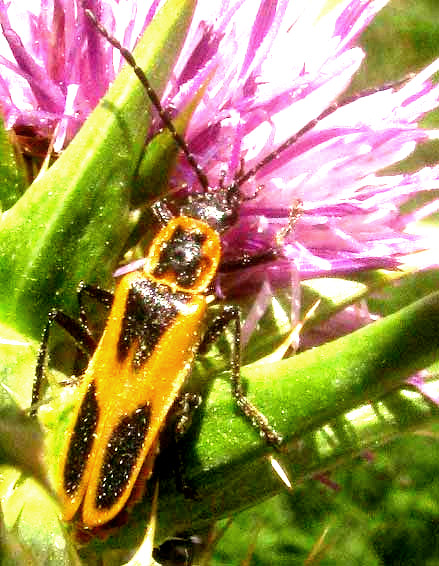Excerpts from Jim Conrad's
Naturalist Newsletter
from the May 18, 2014 Newsletter issued from the Frio Canyon Nature Education Center in the valley of the Dry Frio River in northern Uvalde County, southwestern Texas, on the southern border of the Edwards Plateau; elevation ~1750m (~5750 ft); N29.62°, W99.86°; USA
USING BUGGUIDE.NET TO IDENTIFY THE TEXAS SOLDIER BEETLE
Sometimes our volunteer insect identifier Bea in Ontario gets back to me faster with identifications than I thought possible. I mentioned this to her the other day and she let me in on one of her IDing tricks. I'd sent her a picture of a beetle lounging on a flowering head of a Milk Thistle, Silybum marianum, encountered in Cooks Slough Nature Park on Uvalde's south side, so Bea told me how she came up with that insect's ID. The beetle's picture appears below.

Here's how Bea identified the beetle:
1) First go to BugGuide's entry page at http://bugguide.net/ Note that on the left side there's a "Clickable Guide" consisting of simple drawings of many kinds of insects. Because of our insect's hard forewings covering soft, pliable wings beneath the hard covering, Bea knew that our unknown insect was a kind of beetle, so she clicked the beetle icon shaped something like a junebug toward the chart's bottom, in the middle.
2) Clicking the beetle takes us to the page for beetles, Order Coleoptera, where there's interesting text about beetles in general, and some pictures of them. At the top of this page, click on the "Browse" tab.
3) The Beetle-order Page's "Browse" tab takes us to a new page showing pictures of beetles in the four beetle "suborders." Bea writes about the approach at this point: "For beetles we have four choices. Scroll through the pictures and find those looking most like your beetle. Sometimes there is more than one group looking like yours, so just check them all. For the one in our picture I chose "Suborder Polyphaga." So click on the Polyphaga link.
4) The Suborder Polyphaga is a big one. Notice that at the top of that page links are provided to four different pages. Each page holds pictures of beetles in various "superfamilies." Once again, just scroll through the pictures on all four pages until you find images more or less matching your unknown. Our image most matches the "Superfamily Elateroidea" profiled on the second page, so click on the "Superfamily Elateroidea" link.
5) On the Superfamily Elateroidea Page, we find links at the top to three pages profiling beetle "families." Browsing through all three pages, on the last page, "Family Cantharidae," the Soldier Beetles, is chosen. Click that.
6) On the Family Cantharidae Page, several "subfamilies" are profiled. "Subfamily Chauliognathinae" is chosen and that link in clicked.
7) On the Subfamily Chauliognathinae Page, the genus Chauliognathus is chosen, so click on that.
8) On the Genus Chauliognathus Page we find four pages of soldier beetle species illustrated. Bea writes: "Here there's a few that look like yours, for example the first one Chauliognathus basalis - Colorado Soldier Beetle -- click on that one. From here you click on "Info," which gives you any information that Bugguide.net knows about that species, host plants, habitat, size, range. It says they are in Texas. Now click on the "Data" tab that shows a distribution map, and we see they don't seem to be common in Texas. Searching on we come to Chauliognathus omissus, also looking like yours but the map with the "Data" tab doesn't show them in Texas. And so on until we come to: Species Chauliognathus scutellaris. And BINGO!! There's lots in southwestern Texas, and I'm pretty sure we have a match!"
Though Chauliognathus scutellaris mostly occurs in Mexico, in te US, because it's found mainly in Texas (also, at least, in southern Arizona), often it's called the Texas Soldier Beetle.